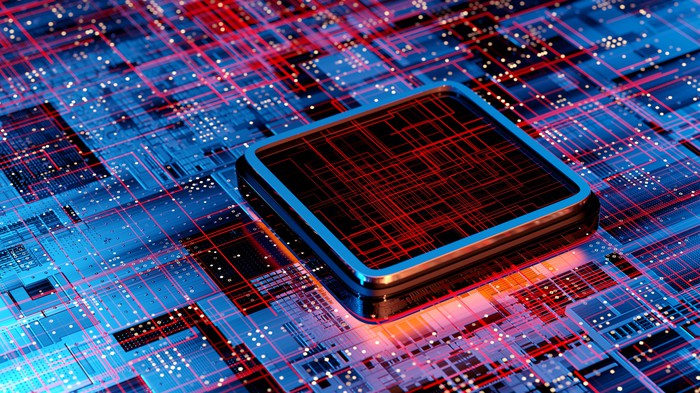Intel's (NASDAQ:INTC) stock recently slumped after the chipmaker posted its first-quarter earnings report. Its revenue and earnings surpassed Wall Street's conservative estimates, but its guidance indicated its slowdown would continue as it grappled with its chip shortage and R&D issues.
Intel's manufacturing plans, which include investments in new plants and the launch of a new foundry unit for third-party chipmakers, also defied calls for the company to become a fabless chipmaker like Advanced Micro Devices (NASDAQ:AMD).
Intel also postponed the launch of its long-delayed 7nm chips to 2023, which indicates it will fall further behind Taiwan Semiconductor Manufacturing (NYSE:TSM) and Samsung in the "process race" to manufacture smaller and more advanced chips. Intel will also reportedly rely on TSMC's plants to produce those 7nm CPUs.
Image source: Getty Images.
Factoring in all these challenges, Intel expects its adjusted revenue and earnings to decline 7% and 13%, respectively, for the full year. Intel's stock might look like a bargain right now at 13 times forward earnings while paying a forward dividend yield of 2.4%, but it's cheap for obvious reasons.
Instead of waiting for Intel's glacial turnaround efforts to possibly bear fruit, investors should simply buy AMD or NVIDIA (NASDAQ:NVDA) as their main semiconductor plays instead.
1. AMD is catching up to Intel again
AMD is a fabless chipmaker that outsources the production of its chips to third-party foundries like TSMC. Intel manufactures most of its chips internally, but its own foundries struggled to make the more efficient chips that TSMC specializes in.
As Intel postponed its latest chips and struggled with shortages, AMD pulled ahead of Intel in the process race by using TSMC's superior plants. Many PC makers then started using AMD's chips instead of Intel's.
As a result, AMD's share of the x86 CPU market rose from 20.2% to 38.4% between the second quarters of 2017 and 2021, according to PassMark Software. Intel's share dropped from 79.7% to 61.5%.
Image source: Getty Images.
AMD's latest Ryzen and EPYC CPUs are built on TSMC's 7nm process, putting it one generation ahead of Intel, even though Intel claims its 10nm node is comparable to TSMC's 7nm node. But AMD will likely launch its new 5nm CPUs later this year, which will put it firmly ahead of Intel's 10nm chips.
AMD's revenue rose 45% to $9.76 billion last year. Its computing and graphics revenue rose 37% to $6.43 billion, fueled by robust demand for its Ryzen CPUs and Radeon GPUs. Its EESC (enterprise, embedded, and semi-custom) revenue soared 65% to $3.33 billion as it sold more EPYC server chips and custom chips for new gaming consoles. Its adjusted earnings more than doubled.
Wall Street expects AMD's revenue and earnings to rise another 48% and 67%, respectively, this year, as it continues to gain ground against Intel in the PC and data center markets. It will also likely keep pace with NVIDIA in the high-end GPU market, which should benefit from the launches of new games and demand for new cryptocurrency mining cards.
2. NVIDIA is becoming a disruptive superpower
Like AMD, NVIDIA is a fabless chipmaker that relies on TSMC and Samsung instead of manufacturing its own chips.
NVIDIA's brand is often associated with gaming GPUs, but it also supplies high-end GPUs to data centers for AI and machine learning tasks. Its smaller Arm-based CPU business sells Tegra CPUs for embedded systems and Grace CPUs for servers, while its recent takeover of Mellanox expands its data center business with sales of networking equipment.
NVIDIA's revenue surged 53% to $16.7 billion in fiscal 2021, which ended this January, as its adjusted earnings soared 73%. Its strong sales of GPUs for gaming PCs and data centers offset softer sales of its professional visualization and automotive chips throughout the pandemic.
Analysts expect NVIDIA's revenue and earnings to rise 34% and 35%, respectively, this year. But those estimates likely haven't factored in its planned $40 billion purchase of Arm Holdings, the U.K.-based chip designer that provides the architecture for nearly all of the world's mobile devices, from the Japanese conglomerate SoftBank (OTC:SFTBF).
That proposed takeover faces a lot of regulatory challenges, but it could transform NVIDIA into a semiconductor superpower, for two reasons. First, all of the world's Arm-based chipmakers would need to pay NVIDIA high-margin royalties and licensing fees. Second, it could design and manufacture new high-end Arm chips -- like its new Grace CPU -- to challenge Intel and AMD in the PC and data center markets.
The bottom line
AMD and NVIDIA trade at about 30 and 40 times forward earnings, respectively. AMD doesn't pay a dividend, while NVIDIA pays a tiny forward dividend yield of 0.1%.
Value-seeking investors might shy away from those higher valuations and stick with Intel, but that would be a mistake. AMD and NVIDIA deserve their premium valuations, and they should continue to grow as Intel struggles to undo years of bad management decisions.


精彩评论